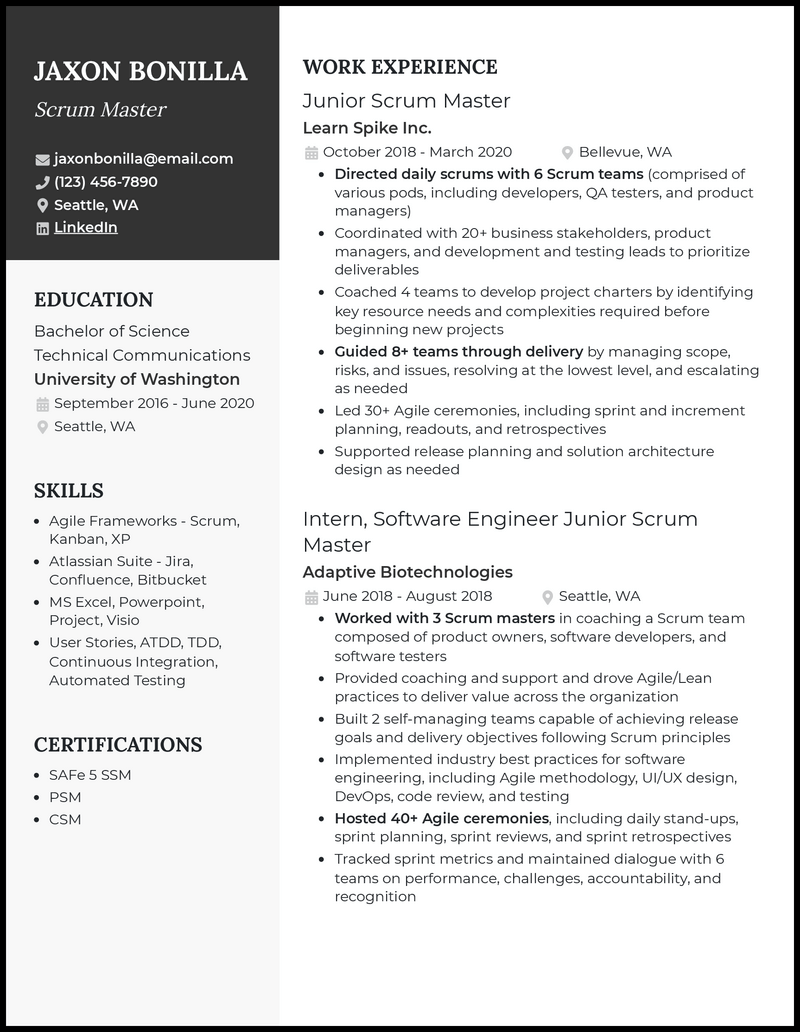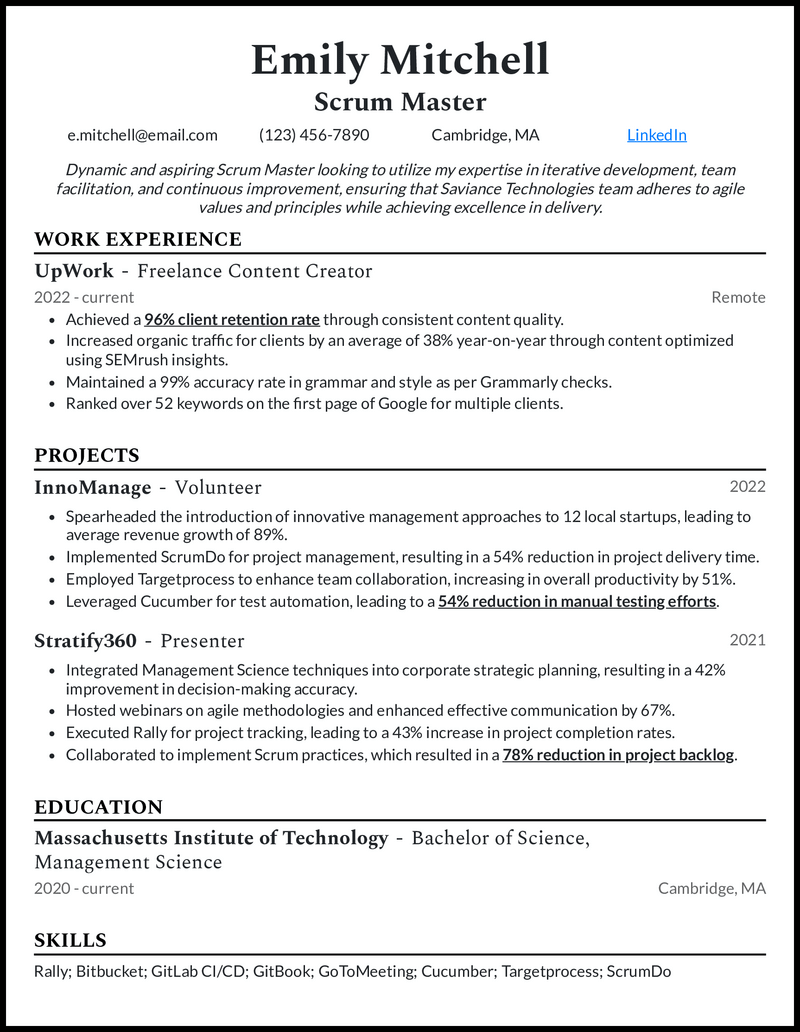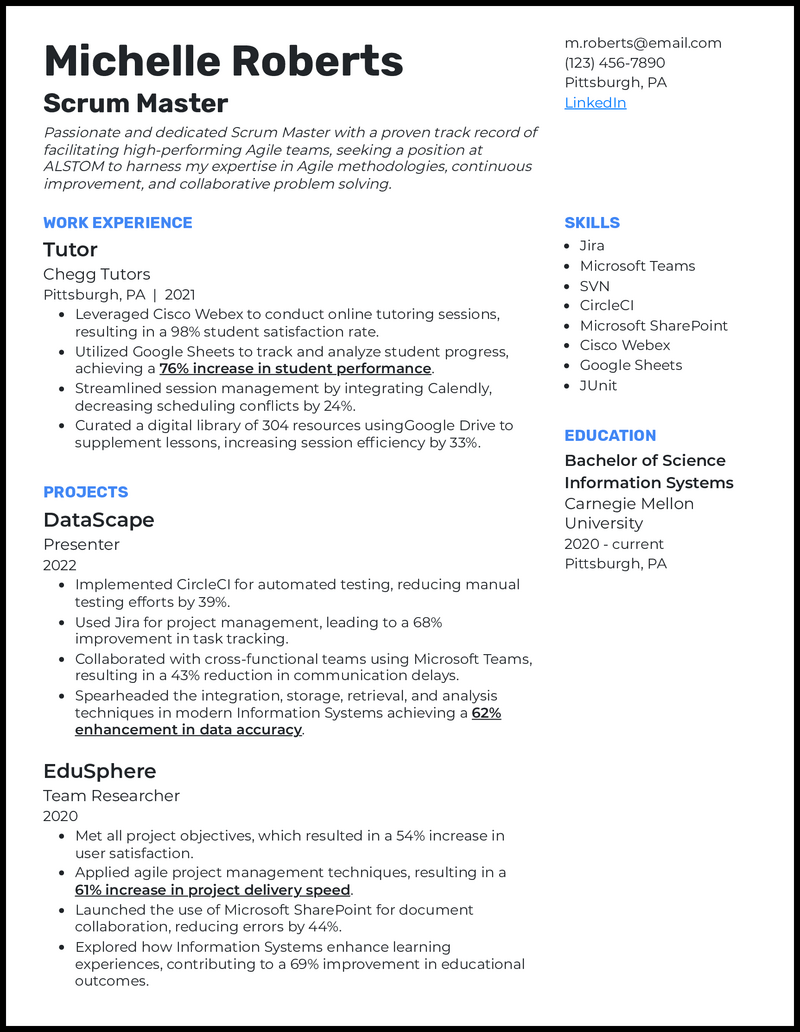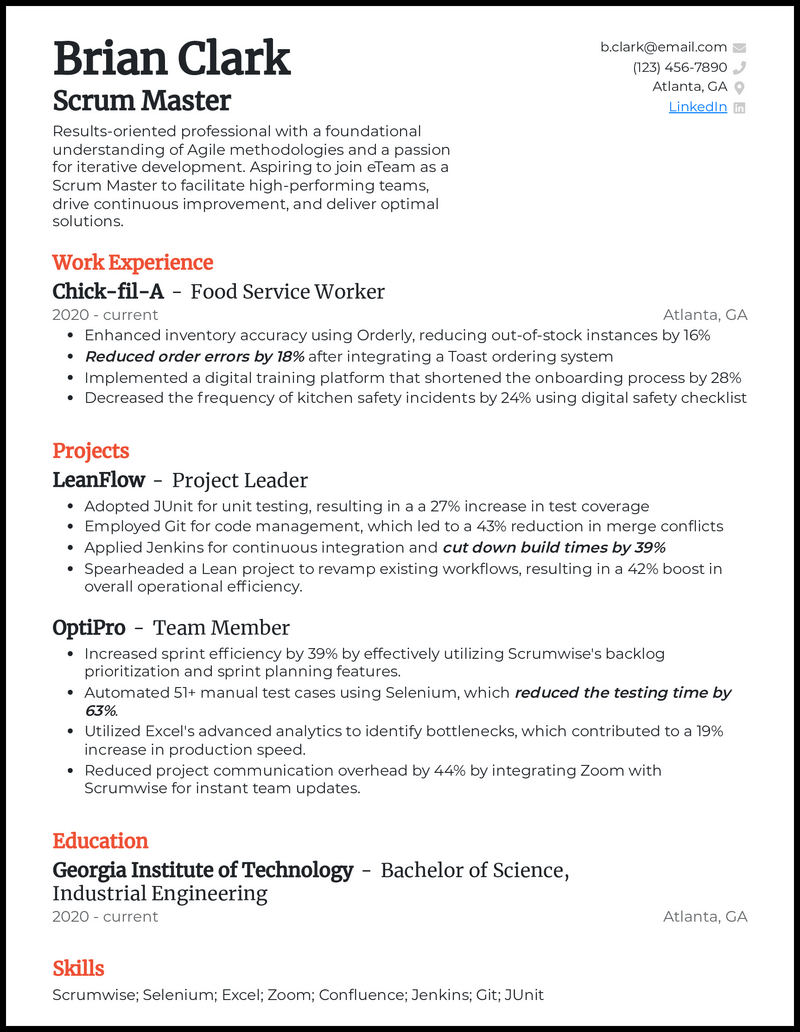
Entry-Level Scrum Master





Best for senior and mid-level candidates
Resume Builder
Like this template? Customize this resume and make it your own with the help of our Al-powered suggestions, accent colors, and modern fonts.
Crafting the best entry-level Scrum Master resume means showcasing your leadership mindset, even without years of experience—clarity, structure, and relevance are your power tools.
Learn how to make your resume stand out and explore free, modern resume templates to give your application a polished, professional edge.
In this guide, you’ll discover:
- ↪ 5 Entry-level Scrum Master resume examples that work
- ↪ Practical resume tips tailored for Agile beginners
- ↪ Job-winning strategies that are bound to help you sprint to your dream role
Related resume examples
How to Write an Entry-Level Scrum Master Resume

Landing your first job as a Scrum Master without any experience might feel like cracking a code without the key, especially when most job descriptions ask for experience.
Summary
Kickstart your agile career with a laser-focused entry-level scrum master resume that proves your potential, communicates value clearly, and gets past the ATS into interview territory.
However, putting your value first for recruiters to see can get you past the door and on your way to a great career.
Look in your school and work journey for anything related to the role. Projects, internships, classwork, and anything else that taught you valuable lessons that can be transferred to the real workplace can change the odds in your favor.
Use a clear structure, keep it to one page, and focus on accomplishments—even from academic or volunteer projects. If you want inspiration, check out these resume examples that showcase what success looks like at the entry level.
Here you’ll learn:
- What hiring managers look for in a junior Scrum Master
- How to tailor your resume even if you don’t have direct Scrum experience
- Key sections every entry-level Scrum Master resume must include
- Smart ways to showcase transferable skills from non-Agile roles
- How to use certifications (like CSM) to boost your credibility
- Tips for writing a strong summary that positions you as a team facilitator

Open with a powerful career objective
Your resume needs a strong opening. That’s your career objective—a concise, punchy statement that communicates your career intention and why you’re the right fit. Don’t just say you want a Scrum Master role. Instead, prove your value in 2–3 lines.
Weak: Looking for a job as a Scrum Master to gain experience.
Strong: Certified Scrum Master with a strong foundation in Agile principles, a background in team facilitation during software capstone projects, and a passion for delivering user-focused digital products, seeking to drive results in a dynamic software development team at Atlassian.
Pro tip: Use tools like a summary generator if you’re stuck turning your background into a punchy objective.

Impress recruiters with in-demand skills
In a technical role involving Scrum, efficiency and results are what matter! Let’s break that down into more detail and analyze what recruiters really want for an entry-level Scrum Master role.
You want to show that you know your role in each sprint by being extremely profession-focused in your skills section. While a few broader skills like various Microsoft or Google Suite tools are bound to come into play, you’ll want to place more emphasis on what makes you stand out.
Be specific and hone in on exactly how you offer unique benefits to the company. List specific programs or practices, like Kanban or Agile, that you leverage within your role.
9 best entry-level Scrum Master skills
- Kanban
- Agile Methodologies
- Jira
- Confluence
- Continuous Integration
- Automatic Testing
- User Stories
- Bitbucket
- MS Excel

Demonstrate your value from relevant work/projects
Your skills are already impressive on their own—don’t worry. But examples of how you’ve put them to good use in the past are even more impressive! Recruiters want to see that you’re able to tap into a working knowledge of scrum that will help their company thrive.
Pull any relevant, impressive examples from your past roles and see which are the best: Which points include the key components of a compelling scrum master achievement: the what, why, how, and the results?
And don’t forget to include quantifiable data that provides metrics for those results! By including numerical support for your claims to Agile greatness, you sound much more credible.
Here are some good ideas based on our sample resumes:
- Hosted over 41 Agile ceremonies, including daily stand-ups, sprint planning, sprint reviews, and sprint retrospectives to boost efficiency by 11%
- Implemented industry best practices for software engineering, including Agile methodology, UI/UX designs, DevOps, code review, and testing to help elevate positive product feedback by 23%
- Directed daily scrums with six Scrum Teams comprised of various pods including developers, QA testers, and product managers to reduce work hours by 12 per month
- Guided over eight teams through delivery by managing scope, risks, and issues, resolving at the lowest level, and escalating as needed to reduce errors in the final product by 9%

Tailor your resume to the role, company, and industry
You’ll never find a Scrum Master job similar to another one, even at the entry level. The jobs are different, employers are looking for a specific candidate, and each industry has benchmarks.
If your resume doesn’t address the specific needs of the employer, the job, and the industry, you won’t get the job.
Here’s a winner’s strategy you can use:
- Use a LinkedIn resume builder to pull in real job listings and optimize your content around them
- Customize your skills and tools based on what’s in demand for that company
- Swap out generic phrases like “team player” for more relevant ones like “collaborated with cross-functional Agile teams to deliver MVPs.”
Pro tip: Track every role you apply to and how you’ve tailored your resume for it using a job tracker—it makes refining your strategy and following up easier.

Make good use of your education and certifications
When you’re starting, your education and certifications are your best assets. Whether it’s a Computer Science degree, a bootcamp, or even an MBA—tie each qualification directly to agile thinking, communication, and problem-solving.
When it comes to your education, almost anything will do the trick since leadership can stem from any coursework. So, a Bachelor’s in Business Administration and a Bachelor’s in Information Systems are equally relevant.
Only mention specific courses if they are related to scrum.
List your certifications right after your career objective or in a dedicated section. Highlight the most relevant ones in your headline using a tool like a headline generator to grab recruiters’ attention at first glance.
Since you’re only starting out, we recommend the certs below:
- Professional Scrum Master™ I Certification
- Professional Scrum™ with Kanban Certification
- Certified ScrumMaster (CSM)

Showcase impact from work experience and projects
There’s no rule that says your first sprint has to be in a job, so even if you don’t have any internship or work experience, you can always present any college projects you’ve led.
These will show your ability to tackle challenges and use a scrum mindset. If you haven’t contributed to any projects, now’s the time to make your own.
Even if you haven’t had a formal Scrum Master title, you can still show leadership, facilitation, and process improvement from internships, school projects, or even part-time jobs.
Which projects were you part of, and what did you learn? What did you do during your internship?
For example:
- Volunteer: Search for any local NGO or charity drive that needs help organizing their projects. Volunteer to help them and create a streamlined structure for the team.
- Case Study: Create a detailed case study on a past business decision or journey and implement how you would’ve applied scrum and what benefits it would have.
All these activities can become your anchors to showcase what you can do once you have the job.
To put yourself in a position of power, use the formula below:
Action Verb + What You Did + Tools/Methodologies + Result/Impact

Demonstrate readiness for continuous learning
One thing about a Scrum Master’s career is that learning doesn’t stop. You should never have a period in your career history where you are dormant; keep adding skills, technologies, and innovative ways of doing things.
It may be reading a book about the latest development, writing an article about your discoveries, or attending a conference to learn from an authoritative figure. Articulate what you learned, how it keeps you updated, and your urge to remain at the forefront of discoveries and new knowledge.
For your heads up, platforms like LinkedIn resume builder can help link learning milestones directly into your profile.
Top 5 tips for your entry-level scrum master resume
- Show versatility
- At an entry level, you’re likely to wind up adapting your skill set to the needs of more experienced Scrum Masters. Show that you’re ready for anything by pulling in different examples that tell an exciting variety of success stories! Your willingness to learn can go a long way.
- Switch your context around
- At times, it can be a struggle to come up with metrics that don’t just look like a lineup of percentages. It’s okay to have plenty of improvement or error reduction percentages on your resume as long as the context isn’t redundant—but it helps to bring in other metrics, like reduced labor hours thanks to your Agile proficiency, too.
- Use a super-clean template
- Again: Scrum is all about efficiency and streamlining the pathway to optimal results. Show recruiters that you have a grasp on this by showing them a visually sleek resume template. Pick a template that sets off your key selling points but still leaves some room to breathe!
- Get creative with your experience
- Not everyone has a lineup of previous junior roles that they can put on their entry-level Scrum Master resume, but that’s all right! If you’re a bit short on professional, paid experience, you can always bulk up your personal history with college projects, internships, or community programs as long as they’re relevant to Scrum. Spent time making a cover letter that shows how this kind of experience translates to the Scrum role.
- Call for backup!
- If you’re still struggling to feel confident that your application package contains enough qualifying information, you can always supplement your resume with letters of recommendation. A good word from other professionals familiar with Scrum values or software always helps!
Entry-Level Scrum Master Resume FAQs

One critical aspect of an entry-level scrum master resume that wins the job is that it aligns with the expectations of recruiters and perfectly matches the ability to take on all the responsibilities. Therefore, to improve your resume, ensure it is tailored to mirror the exact persona of the best candidate. Once you do that, you’ll easily pass online job screeners and impress recruiters.
Review the job posting to understand what the potential employer is looking for. You’ll notice key terms, some of which are the non-negotiable skills for the job. Do you have some of those competencies? Put them in a u0022 Skills u0022 section and use them in your bullet points.




![5 Entry-Level Scrum Master Resume Examples & Templates [Edit Free]](https://beamjobs.wpenginepowered.com/wp-content/uploads/2023/03/entry-level-scrum-master-elegant-resume-example.png)








